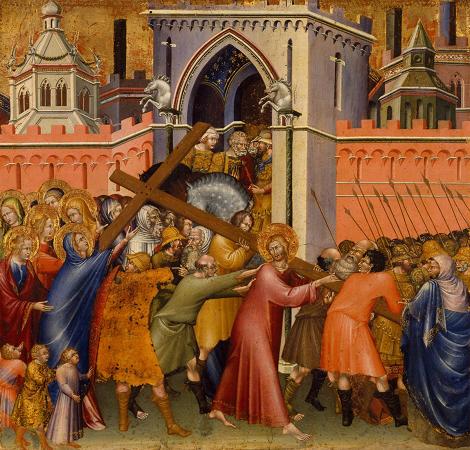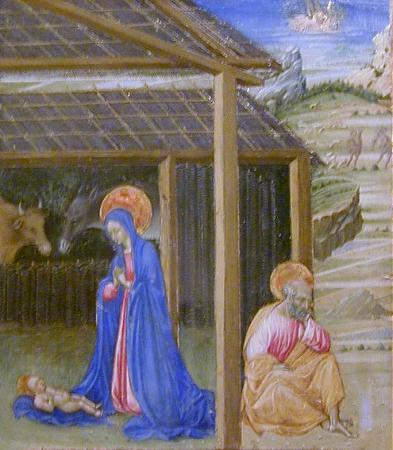Giovanni di Paolo (c1403 - 1483). Giovanni di Paolo di Grazia was an Italian painter, working primarily in Siena, becoming a prolific painter and illustrator of manuscripts, including Dante's texts. He was one of the most important painters of the 15th century Sienese School. His early works show the influence of earlier Sienese masters, but his later style was more individual, characterized by cold, harsh colours and elongated forms. His style also took on the influence of International Gothic artists such as Gentile da Fabriano. Many of his works have an unusual dreamlike atmosphere, such as the surrealistic Miracle of St. Nicholas of Tolentino painted about 1455 and now housed in the Philadelphia Museum of Art, while his last works, particularly Last Judgment, Heaven, and Hell from about 1465 and Assumption painted in 1475, both at Pinacoteca Nazionale, are grotesque treatments of their lofty subjects. Giovanni's reputation declined after his death but was revived in the 20th century. The exact year of the birth of Giovanni di Paolo di Grazia is unknown. He was first documented in 1417 working for the Sienese Dominican Order as a miniaturist. Northern, Franco-Flemish influences have been discussed in his work, particularly in the landscapes, and some have speculated he apprenticed with the Limbourg Brothers who were in Siena about 1413, although this remains inconclusive, and apprenticeships with Taddeo di Bartolo and Martino di Bartolomeo have also been proposed. Most of Giovanni's commissions came from local monastic communities which is apparent because so many of his early works are altarpieces for such churches. For example, The Virgin and Christ Child with Saints Bernardino, Anthony Abbot, Francis and Sabina and The Lamentation Over the Dead Christ, a square panel painting altarpiece commissioned by Pope Pius II for his recently finished cathedral. Most of the paintings that Giovanni di Paolo is known from today are in fact panels and fragments from disassembled altarpieces and predellas. Notable examples include series of panels depicting Saint Catherine of Siena, Saint Clare of Assisi, and Scenes from the Life of Saint John the Baptist, which are now all scattered in museums and collections throughout Europe and North America. Giovanni di Paolo is known to have painted four altarpieces for chapels in San Domenico, Christ Suffering and Triumphant, the Pecci Altarpiece, the Branchini Altarpiece, and the Guelfi Altarpiece which included Paradise now in the Metropolitan Museum of Art, New York. Giovanni di Paolo was influenced by many great artists in Trecento and Quattrocento, Italy. It is believed that he may have owned a model book of other artists' work he could flip through and use that would fit his paintings. A few of these include the following: Gentile da Fabriano's two Florentine altarpieces, Ambrogio Lorenzetti's Presentation in the Temple, and the Baptistery reliefs by Donatello. He would then be able to alter, modify, and combine these artists' works into his own renderings. Throughout his career one can see how this model book was utilized because of certain figures he repeatedly used, His isolated detail, a single figure, or group copied from another image is shown that he is naturally drawn to the inventions of his fellow artists. However much it would be looked down upon today to copy, in Trecento and Quattrocento Siena, the culture valued an artist that could manipulate others' work and make it their own as creatively as Giovanni did. Giovanni di Paolo was influenced by many artists during his time, which can be seen in a number of his paintings. Giovanni's Raising of Lazarus is based on the same scene of Duccio's Maesta. But where Duccio's figures are sober and restrained, Giovanni di Paolo's are voluble and animated. Giovanni was open to solutions other than the Sienese tradition which, .made him receptive to sources farther afield as well. One of these is the occasion where he painted a picture he had drawn from a mural in Assisi. His work and style show the transition from the Sienese and Gothic style into the Renaissance. His style also took on the influence of International Gothic artists such as Gentile da Fabriano. He was an artist of great consequence who had been invited by Pope Martin V to Rome. On his way to Rome, Gentile stopped in Siena, where Giovanni quickly assimilated Gentile's techniques. One technique he kept was Gentile's fascination with nature. Instead of using standing saints, as was customary, in his painting Giovanni used sprigs of flowering plants.
more...














